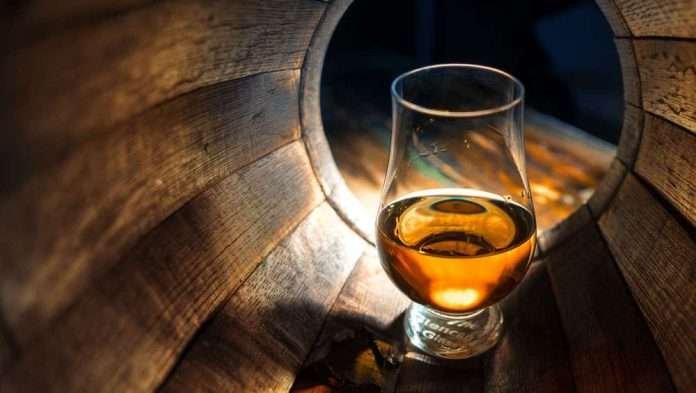India has surpassed France to become the world’s largest consumer of Scotch whisky by volume, according to the UK-based Scotch Whisky Association (SWA). The SWA, which publishes an annual list of the top Scotch whisky-consuming countries, also noted that Scotch whisky exports to India have grown by over 200% in the past decade.
The term “whisky” derives from the Gaelic “uisce beatha” or “usquebaugh,” meaning “water of life.” Whisky is produced by fermenting a mash of grains, some of which may undergo the malting process. The grains used include barley, corn, rye, and wheat, each imparting unique characteristics to the final product. Whisky is further refined through aging in wooden casks, often made of charred white oak, which contributes to its complex flavors and aromas. Whisky is categorized into single malt and blended varieties, each comprising a spectrum of nuanced sub-varieties.
Indian Whiskies Gain Global Recognition
Indian whiskies are gaining global recognition for their exceptional quality and distinct character. Indri, a single malt whisky produced by Piccadily Distilleries, recently ranked number one at the Whiskies of the World Awards 2023. This achievement further cements India’s position as a leading producer of world-class whiskies.
Indian Whisky Market Experiencing Strong Growth
The Indian whisky market is experiencing strong growth, driven by innovative offerings and a growing appreciation for premium spirits. According to the International Wine and Spirit Research (IWSR) organization, whisky accounts for nearly two-thirds of spirits sales in India. Industry experts anticipate continued growth, with annual sales projected to increase by nearly 30% in the coming years.
Premium Whisky Brands Leading the Charge
Premium whisky brands such as Indri, Paul John, Rampur, GianChand, and Amrut are at the forefront of India’s whisky revolution. These brands are not only gaining popularity domestically but are also making inroads into international markets.
Indian Whisky Brands Creating Unique Narratives
Indian whisky producers are consciously crafting distinct narratives that draw upon India’s rich heritage and distinct terroir. This approach sets Indian whiskies apart from their counterparts, establishing a unique identity in the global whisky landscape.
Future Outlook: India as a Major Global Whisky Player
Industry experts are optimistic about the future of Indian whisky, predicting that India will emerge as a major global player in the premium whisky market. With a growing appreciation for Indian whiskies and a commitment to innovation, India is poised to become a force to be reckoned with in the world of whisky.
John Distilleries
 According to the International Wine and Spirit Research (IWSR) organisation, whisky accounts for nearly two-thirds of spirits sales in India. Kumar says the Indian whiskey sector is experiencing strong expansion, thanks to its innovative offerings. In 2022, the performance of Indian single malts was impressive, with sales reaching just over 2 million cases of 9 litres, he says. “I anticipate this growth rate will soar even higher, approaching nearly 30 percent annually in the years to come.”
According to the International Wine and Spirit Research (IWSR) organisation, whisky accounts for nearly two-thirds of spirits sales in India. Kumar says the Indian whiskey sector is experiencing strong expansion, thanks to its innovative offerings. In 2022, the performance of Indian single malts was impressive, with sales reaching just over 2 million cases of 9 litres, he says. “I anticipate this growth rate will soar even higher, approaching nearly 30 percent annually in the years to come.”
Premium whisky players in India include Indri, Paul John, Rampur, GianChand and Amrut, while non-premium brands include Blenders Pride and Royal Stag, among others. While some of these brands go back several decades, others were established less than 30 years ago. For example, Haryana-based Piccadily Distilleries started in 1953, when KN Sharma started a liquor company and then a standalone bar in Chandigarh. After venturing into other businesses, such as a restaurant and a theatre, the Sharma family purchased a sugar mill and distillery, and entered the alcohol manufacturing and distillery business in 1994.
Around the same time, Paul P John, chairman of Goa-based John Distilleries, started his own liquor company in 1992 and established John Distilleries in 1996. “My father had been in the alco-bev retail business and I developed an interest for the business fairly young. Over the years, as I travelled and visited distilleries, especially in Scotland, it occurred to me that we in India should be able to produce world-class quality whisky too,” says John. In 2008 he set up the malt plant in Goa, which led to the launch of Paul John Indian Single Malts in the UK in 2012. “It has been a great journey ever since.” The company’s flagship brand, Original Choice, is one of the top selling brands in India and is one of the top 10 selling whiskies worldwide, with sales exceeding 11 million cases a year.
John Distilleries has won many awards, including the ‘Asian Distillery of the Year’ three times in a row. It is one of the largest liquor companies in the country by volume, and is spread across 18 states in India and 44 countries, adds John.

Amrut premium whisky
Another big name in the sector, and older than Piccadily and John, is Amrut Distilleries, established in 1948 by Radhakrishna N Jagdale in Bengaluru. In 1972, Neelakanta Rao Jagdale, the company chairman, joined his father’s business and were pioneers in the premium Indian whisky segment. By the late 1970s, the distillery started making malt whisky. On August 24, 2004, Amrut launched India’s first single malt whisky, Amrut, at an Indian restaurant in Glasgow called Cafe India. “The genesis of marketing the single malt whisky was my father’s idea,” says Rakshit N Jagdale, the third-generation entrepreneur and executive director of Amrut Distilleries. The whisky was subsequently introduced in India and the rest of the world.
Thrivikram G Nigam, executive director of Amrut Distilleries and Jagdale’s brother-in-law, says in the 1990s, restaurants and bars around the world did not see India-made whiskies to be of great significance. “It was then that Amrut Distilleries decided to launch its premium Indian whisky and made a mark in the premium segment globally.” Today, Amrut sells close to 120,000 cases of its single malt whisky in more than 22 states in India and 57 countries, with close to 40 expressions, adds Jagdale.
“The beauty of our whisky is how proudly we make and sell it across the world, without a comparison to other countries. It is a 100 percent Indian product, with Indian touches, distilled in Bengaluru, matured in Bengaluru, and bottled in Bengaluru,” says Jagdale. Nigam adds: “We keep learning about whiskies across the world, and don’t take much time to bring those learnings to our offerings.”

John sees competition differently. “In my view, we are not in a state of competition, as we are all committed to building the Indian single malt category for India and the world. The Indian single malt players have consciously created our distinct narratives, drawing from our provenance of vast Indian heritage and hence do not compete with each other.”
Amrut has appointed distributors for global sales, while in India it distributes its own whiskies. John Distilleries has set up a strategic partnership with Sazerac, an American beverage company, which distributes its products in the US, the UK and Australia. “We have dovetailed our distribution with Sazerac distributors world-wide. It benefited us to leverage the combined strength of the portfolio,” says John.
 Amrut plans to enter new geographies, and recently entered the South American and African markets. “We want to first increase our footprint in India and then across the world,” says Nigam. It also plans to increase its capacity by 30 percent. “I am positive about the future of Amrut and India in the whisky space. I’m sure India will emerge as a strong competitor in the world market, producing quality liquids,” Jagdale says.
Amrut plans to enter new geographies, and recently entered the South American and African markets. “We want to first increase our footprint in India and then across the world,” says Nigam. It also plans to increase its capacity by 30 percent. “I am positive about the future of Amrut and India in the whisky space. I’m sure India will emerge as a strong competitor in the world market, producing quality liquids,” Jagdale says.
“The single malt story in India, which started with a lone Indian brand, is now evolving to an Indian single malt category that’s leading the way,” John says. Recently, John Distilleries began its journey indexing global whisky markets like UK, the US and Europe to have quicker wins and have also started litmus testing its world-class quality. “We are sometimes met with curious reception or disbelief that we Indians could make whisky. Single malts from India is now the emerging category, along with other regions like Australia, France, Italy and the US, and I have high expectations that the Indian single malt sector will reach great heights.
Radico Khaitan Ltd.

Radico Khaitan Limited is an Indian company that manufactures Indian-made foreign liquor (IMFL). The company was founded in 1943 and is headquartered in Rampur, Uttar Pradesh, India. Radico Khaitan is one of the largest producers of IMFL in India and its products are exported to over 30 countries. The company’s flagship brand is Rampur Indian Single Malt Whisky, which is a premium single malt whisky that is aged in oak barrels for at least 12 years
Rampur Select, Double Cask, and Asava are all expressions of Rampur Indian Single Malt.
“India produces some 48 percent of all whisky in the world,” says Sanjeev Banga, president of international business of Radico Khaitan, the parent company of Rampur Distillery. “Most of the stock stays within India’s borders, but thanks to some producers like us, our wonderful whisky has gradually made its way to the United States and elsewhere. There are only a handful of Indian whiskies in the United States, with Rampur being one of the most highly regarded.”
The Rampur Indian Single Malt Collection is made from 100% 6 row Indian barley, and the maturation facility, located in the foothills of the Himalayas in Uttar Pradesh, is uniquely suited to the aging of malt spirits due to the extreme seasonal shifts in climate, Banga says. “This allows for Rampur’s singular flavor profile, achieved at a much faster pace than, say, Scotland,” he says.
This collection of single malts is distributed throughout the United States, and “it can be found in some of the top restaurants in cities up and down each coast,” Banga says.
Rampur is a great example of the high-quality whiskies that are being produced in India. With its unique flavor profile and its commitment to innovation, Rampur is sure to continue to gain popularity among whisky drinkers around the world.













